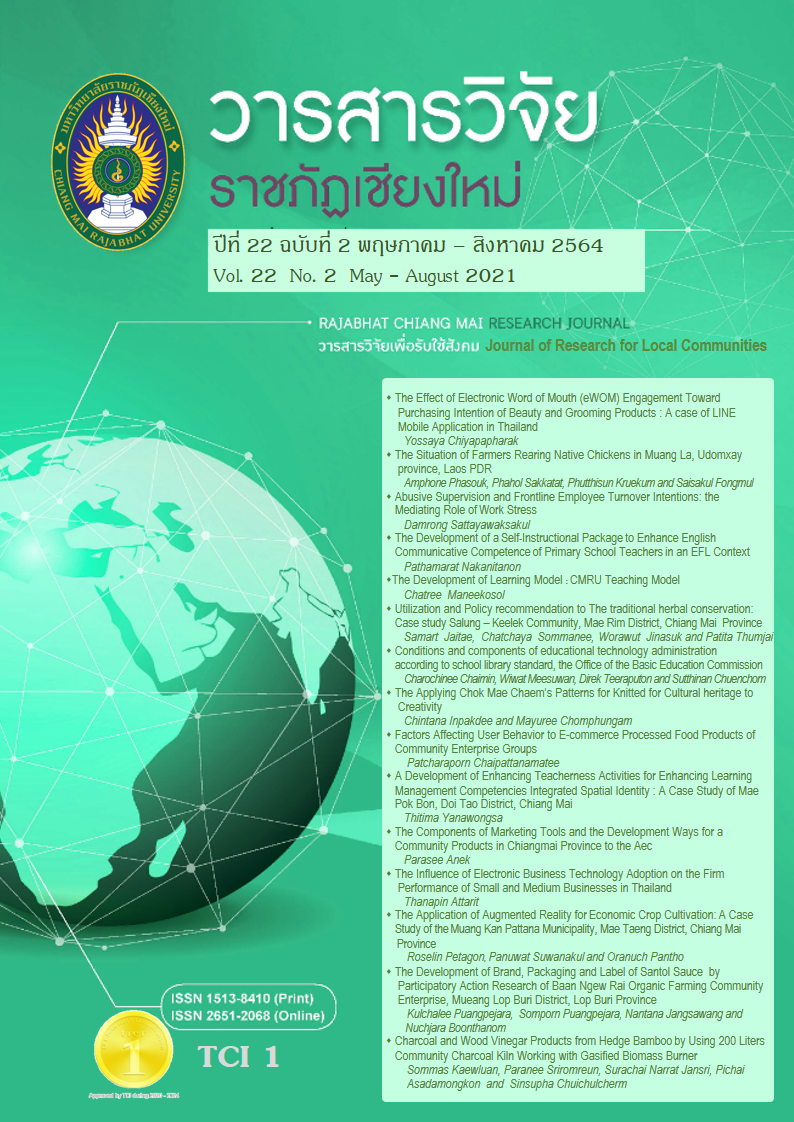การประยุกต์ลวดลายตีนจกแม่แจ่มสำหรับใช้ในงานถักนิตติ้ง เพื่อสืบสานมรดกทางวัฒนธรรมเชิงสร้างสรรค์
DOI:
https://doi.org/10.14456/rcmrj.2021.244592คำสำคัญ:
ผ้าถักนิตติ้ง, การพัฒนาผลิตภัณฑ์, การเพิ่มมูลค่าผลิตภัณฑ์, มรดกทางวัฒนธรรมเชิงสร้างสรรค์บทคัดย่อ
การวิจัยนี้มีวัตถุประสงค์เพื่อ 1) ศึกษาแนวคิดการสร้างมูลค่าผลิตภัณฑ์ผ้าถักนิตติ้งของกลุ่มผลิตภัณฑ์ผ้าและโครเชต์บ้านห้วยทราย ตำบลห้วยทราย อำเภอแม่ริม จังหวัดเชียงใหม่ 2) พัฒนาผลิตภัณฑ์ผ้าถักนิตติ้งที่ประยุกต์จากลวดลายตีนจกแม่แจ่มเชิงสร้างสรรค์ และ 3) ทดสอบตลาดของผู้บริโภคที่มีต่อผลิตภัณฑ์ถักนิตติ้งที่ประยุกต์จากลวดลายตีนจกแม่แจ่ม กลุ่มตัวอย่างที่ใช้ในการวิจัย ได้แก่ 1) กลุ่มผู้ให้ข้อมูลหลัก จำนวน 15 คน 2) กลุ่มผู้บริโภคเป้าหมายที่ใช้ในการสำรวจความต้องการผลิตภัณฑ์ผ้าถักนิตติ้ง จำนวน 100 คน 3) ผู้เชี่ยวชาญที่ใช้ในการประเมินคุณภาพผลิตภัณฑ์ จำนวน 3 คน และ4) กลุ่มเป้าหมายที่ใช้ในการทดสอบตลาด จำนวน 100 คน เครื่องมือที่ใช้ในการวิจัย ได้แก่ แบบสัมภาษณ์แบบกึ่งมีโครงสร้าง แบบสำรวจความต้องการผลิตภัณฑ์กับกลุ่มผู้บริโภคเป้าหมาย แบบประเมินคุณภาพผลิตภัณฑ์โดยผู้เชี่ยวชาญ และแบบสังเกตพฤติกรรมการซื้อของผู้บริโภค วิเคราะห์ข้อมูลโดยหาค่าร้อยละ ค่าเฉลี่ย และส่วนเบี่ยงเบนมาตรฐาน ส่วนข้อมูลเชิงคุณภาพใช้การวิเคราะห์เนื้อหา ผลการวิจัย พบว่า แนวทางการสร้างมูลค่าผลิตภัณฑ์ผ้าถักนิตติ้งของกลุ่มผลิตภัณฑ์ผ้าและโครเชต์ ต้องพัฒนาบนพื้นฐานความสามารถเดิมที่สมาชิกส่วนใหญ่ของกลุ่มสามารถทำได้ และนำลวดลายตีนจกแม่แจ่มมาประยุกต์ใช้ในการถักนิตติ้งให้เกิดความแปลกใหม่ โดยนำภูมิปัญญาท้องถิ่นภาคเหนือมาสร้างสรรค์ลวดลาย ผสมผสานผลิตภัณฑ์ที่ตอบสนองความต้องการของลูกค้าทั้งด้านสีสัน วัสดุ ลวดลาย และขนาดให้เหมาะสมกับการใช้งานจริง สำหรับการพัฒนาผลิตภัณฑ์ผ้าถักนิตติ้งที่ประยุกต์จากลวดลายตีนจกแม่แจ่มเชิงสร้างสรรค์ พบว่า ผู้บริโภคมีความต้องการให้พัฒนาผลิตภัณฑ์มากที่สุด 5 อันดับ ได้แก่ เสื้อ ผ้าคลุมไหล่ หมอนอิง กระเป๋าถือสตรี และชุดบนโต๊ะอาหาร โดยใช้เส้นด้ายฝ้าย กัญชง และเยื่อไผ่ ย้อมสีธรรมชาติในการถักนิตติ้ง ส่วนลวดลายตีนจกแม่แจ่มที่นำมาประยุกต์ใช้ในการพัฒนาผลิตภัณฑ์ คือ ลายกุดขอเบ็ด ลายขันเสี้ยนสำ ลายเชียงแสนหงส์ปล่อย และลายนกนอน ในการใส่ลวดลายจกใช้วิธีการปักตามลักษณะโครงสร้างของผ้าถัก เมื่อนำผลิตภัณฑ์ให้ผู้เชี่ยวชาญประเมินคุณภาพ พบว่า มีค่าคะแนนเฉลี่ย 4.32±0.51 สำหรับการนำผลิตภัณฑ์ถักนิ้ตติ้งไปทดสอบตลาดกับกลุ่มผู้บริโภคเป้าหมาย ในระยะเวลา 3 เดือน พบว่า ผลิตภัณฑ์ที่นำไปทดสอบตลาดและจัดจำหน่ายจริงนั้นเป็นที่ต้องการของตลาด คิดเป็นร้อยละ 81.48 สูงกว่าเกณฑ์ที่กำหนดไว้ คือ ร้อยละ 80
Downloads
เอกสารอ้างอิง
Burapajatana, J. (2016). Applying patterns from Identity of Jok woven textiles of Mae Jam to design of cultural textile products for home decoration. Veridian E-Journal,Silpakorn University (Humanities, Social Sciences and arts), 9(3), 1720-1721. https://he02.tci-thaijo.org/index.php/Veridian-E-Journal/article/view/90823/71303 (In Thai)
Charoenwongsak, K. (2016). Cultural Capital with Thailand 4.0. Retrieved from http://www.bangkokbiznews.com/blog/detail/639453.
Čubrid, S. I., Kožarid, N., & Matkovid, V., M. P. (2015). Knitted patchwork in interior design: Research of matching different textures and colours. Global Journal on Humanites & Social Sciences, 1(1), 378-383.
Mandal, P. (2018). A Study on Traditional Hand Knitted Articles and Its Modernization by Female Craftsman of Manali Village at Himachal Pradesh. International Journal of Engineering Applied Sciences and Technology, 2(12), 5-12.
Qiu, L. & Chen, X. (2012). The Exploitation of Household Knitting Goods Made of Linen. Advanced Material Research, 627(1), 122-124. DOI:10.4028/www.scientific.net/AMR.627.122
Queen Sirikit Sericulture Office Region 2 Udon Thani Province. (2011). Creating Value Added Sericulture. Retrieved https://www.gotoknow.org/posts/441611. (In Thai)
Ruttanateerawichien, K., & Toathom, T. (2018). Increasing Competency of Crochet Local Product in Nong-Now with Participation. Academic Journal Uttaradit Rajabhat University, 12(2), 39-52. https://ph01.tci-thaijo.org/index.php/uruj/article/view/ 92403/83928 (In Thai)
Sailasoot, A. (1996). Principle of Fabric. (10thed.). Bangkok: Tonsai Printing Co., Ltd. (In Thai)
Somboonkul, Y. (2018). Market Testing. Retrieved from http://www.stou.ac.th/stouonline /lom/ data/sms/market/Unit4/MENUUNIT4.htm. (In Thai)
Soodsang, N. (2016). Design research methodology. Bangkok: Odeon store. (In Thai)
Suwanasree, S. (2008). Principles of product development and sensory quality assessment. Department of Agro-Industry, Faculty of Agriculture Natural Resources and Environment, Naresuan University. (In Thai)
Sooksod, T. (2001). Industrial design. Bangkok: O.S. Printing House. (In Thai)
Thongkham, S. (2018). Knitting Production Situation of Ban Huay Sai Community Enterprise. Interview. (In Thai)
Tiengket, N. (2020). Lai Chok Mae Chaem. Chiang Mai: Nopburi Printing. (In Thai)
ดาวน์โหลด
เผยแพร่แล้ว
รูปแบบการอ้างอิง
ฉบับ
ประเภทบทความ
สัญญาอนุญาต
1. บทความ ข้อมูล เนื้อหา รูปภาพ ฯลฯ ที่ได้รับการตีพิมพ์ใน “Community and Social Development Journal” ถือเป็นลิขสิทธิ์ของ Community and Social Development Journal มหาวิทยาลัยราชภัฏเชียงใหม่ และเพื่อให้เผยแพร่บทความได้อย่างเหมาะสมผ่านสื่อสิ่งพิมพ์และอิเล็กทรอนิกส์ ผู้เขียนยังคงถือครองลิขสิทธิ์บทความที่ตีพิมพ์ภายใต้ใบอนุญาต Creative Commons Attribution (CC BY) ซึ่งอนุญาตให้เผยแพร่บทความซ้ำในแหล่งอื่นได้ โดยอ้างอิงต้องอ้งอิงบทความในวารสาร ผู้เขียนต้องรับผิดชอบในการขออนุญาตผลิตซ้ำเนื้อหาที่มีลิขสิทธิ์จากแหล่งอื่น
2. เนื้อหาบทความที่ปรากฏในวารสารเป็นความรับผิดชอบของผู้เขียนบทความโดยตรง ซึ่งกองบรรณาธิการวารสารไม่จำเป็นต้องเห็นด้วยหรือร่วมรับผิดชอบใดๆ














